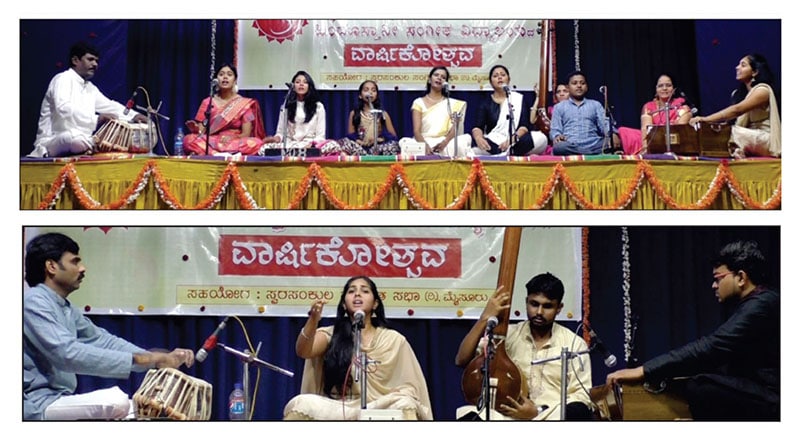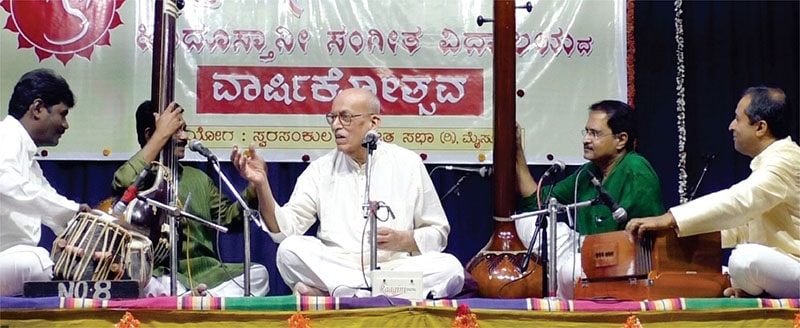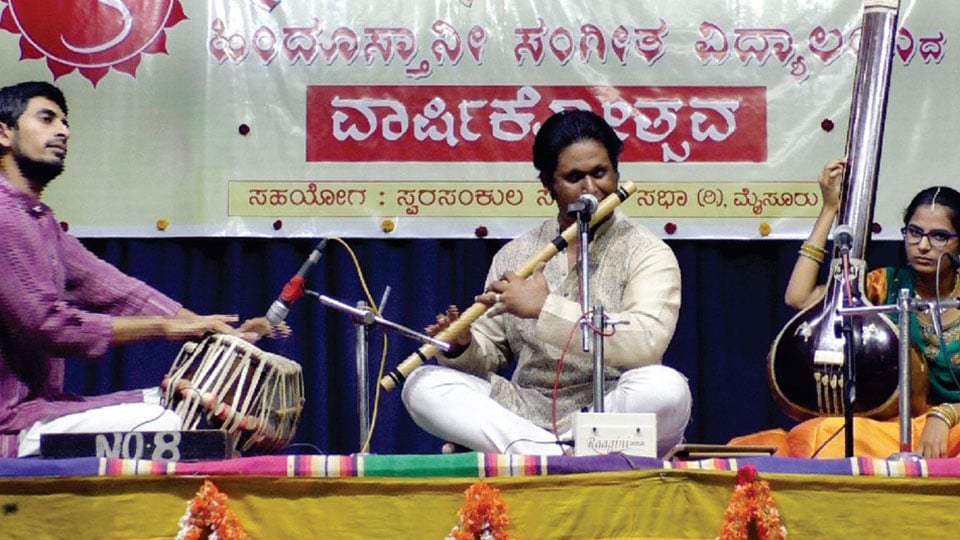By Dr. Rama V. Bennur
Swara Sankula, the Hindustani School of Music celebrates its annual day in a unique way. It always is a combination of fervour, information and education, thus making it interesting to every young and old disciples.
It also motivates them to participate with enthusiasm. The thematic presentations throw light on many aspects of musical history making it more interesting. This year too they had called it ‘Mela-sammela’, which was based on the ‘Thaat’ system of Hindustani style of music.

This 15th anniversary of the School was held on the 24th of December at Vasudevacharya Bhavana. Pandit Veerabhadriah Hiremath, the spirit behind this school, is a well-known Harmonium player and a vocalist.
Before the commencement of the programme, Padmavathi Nirodhi and the students of ‘Arivu’ gave a short performance. Nirodhi sang two songs, ‘Jnanavemba deepa hacchi’ and ‘Enendu bannisali’ penned by her, that had heart touching lyrics. Students of ‘Arivu’, trained by Veerabhadriah, sang in perfect unison a few Vachanas of Allama Prabhu and Akkamahadevi.

The Karanatak music has a perfect system of 72 Melakarta Ragas known for its systematic approach. During 7th cent., it is said that the Rag-Ragini system prevailed in Hindustani music. The Rag Parivar had Male and Female Rag, their offsprings and so on. As often it could not be justified, there was a need for a more scientific and perfect Rag system to follow. Pertaining to the need, it was Sri Vishnu Narayan Bhatkhande (1860-1936) who was aware of the need for a more systematic classifications of the ragas, undertook the gigantic work himself. Pandit Bhatkhande, who knew the classification of 72 Melakartha Ragas by Venkatamakhi, reclassified the Rag-Ragini system and gave ‘Thaat’ system to Hindustani music. He also borrowed the concept of ‘Lakshana Geetha’ from Venkatamakhi and wrote many Bandish to explain the grammar of the raga in an easy to understand way. The four volumes of ‘Hindusthani Sangeeth Paddhathi’ is a result of his hard work, research, dedication and his deep knowledge. Today all Hindustani music lovers are aware of the Thaat system. This programme explained the lakshana of ten Thaats in a nutshell and different groups of students sang a composition or Bandish.

The notes of a particular thaat, its equivalent in Karnatak music, its ‘Janya’ Raags that were announced beforehand were informative and made it more interesting. Rag Shankara, Durga, Hamsadhwani are some of the Janya ragas of Bilaval Thaat. ‘Bijan ban me suman hai phuli’ in Rag Durga was sung by the tiny tots.
Kalyan Thaat and Khamach Thaat were taken up next. ‘Eri aali piya bin’ was presented neatly by the students. Kafi, Bhairav , Purvi, Asavari, Marva, Todi and Bhairavi Thaats were presented by the older students. ‘Dhan dhan murath’ in Bhairav was sung by Sunitha Hiremath, ‘Bal bal jaavu’ and ‘Payaliya jhankar mori’ in purya dhanasri was sung by Nithin Rajaram Shastri and Sameer Rao played a cheez in Poorvakalyan (Marva Thaat) on the Bansuri. Sriram Bhat presented ‘Prabhu ko sumar man mere’ in asavari.

Pandit Indudhar Nirodi brought the curtain down with a very informative talk and impressive singing of Todi and Bhairavi. He explained the history of Rag Todi and the difference between todi, Miya ki todi and Bhairavi. Prior to 16th century, the present Bhairavi was called Todi. Miya Tansen changed a few notes and called it as ‘Miya ki Todi’ which is the present Bhairavi. Bilas Khan, son of Tansen changed the chalan of his fathers Todi (Bhairavi) and brought an entirely changed aesthetic to a new Raga called ‘Bilas khani Todi’. ‘Langar kankariya jin maro’ in Miya ki Todi and ‘Bhavani Dayani’ in Bhairavi were presented by Pandit Nirodhi. Veerabhadriah Hiremath and Dr. Bhaskar gave vocal support.
Sunitha, Ramesh Dhannur, Parameshwar Bhat, Sriram Bhat, Harikrishna Purohit and Veerabhadriah Hiremath gave harmonium and tabla support.








Recent Comments